Phuket Lifestyle – Cheap glasses a sorry sight

PHUKET: Everyone wants to look good in their new shades, but there are some important health issues and practical points to think about before you run out and buy those designer glasses that make you look absolutely fabulous.
The main health reason for wearing sunglasses is to shield your eyes from harmful ultraviolet (UV) rays found in natural sunlight. Overexposure can lead to UV radiation which can cause a myriad of short-term and long-term problems with your eyesight.
The EU standard for UV protection requires 95 per cent of the radiation to be reflected or filtered out and the lenses must also be impact resistant. As of 2009, the European “CE mark”, has been added to the arms of sunglass frames to indicate that they offer a safe level of sun protection.
We turned to optician Somsak Laopratai, the successful operator of Somsak Optic in Phuket Town, to help us with the technical aspects of shopping for a pair of sunglasses.
Mr Somsak advised us that most quality sunglasses in Thailand are imported from Europe, so you just need to check for the CE mark on the arms of the frames.
Recently, high-energy visible light has been implicated as a cause of age-related sight loss. Studies suggest that blue light-blocking (amber-tinted) lenses could benefit patients with age-related eye problems.
Unfortunately, the sunglass standards don’t always address protection from blue light. Often manufacturers simply indicate that the sunglasses meet the blue light blocking requirements of a specific standard rather than indicate a specific level of protection. To be safe, you should consider the color of the lenses. But proceed with caution: all blue or gray lenses, and even some of the yellow or brown lenses, don’t offer blue light protection.
Glass lenses provide the best clarity and are easy to care for, but they’re heavy and they’re not impact-resistant. Consequently, 99 per cent of all sunglasses are now made from plastic. There are three types of lenses to consider: the new plastic, CR39 plastic, and cheap plastic.
The newest type of plastic lenses are available from Oakley and to a lesser extent, Ray-Ban, for about 4000 baht and up. Oakley’s Plutonite lens material is engineered to stop 100 per cent of UVA, UVB, UVC, as well as harmful blue light. These lenses are also impact-resistant.
This type of plastic is innovative because the UV protection and color is blended into the plastic before the lenses are fabricated. A thin film is added to other types of plastic lenses to color or polarize the lens. Over time, this film often separates from the lens.
People who need to wear strong prescription sunglasses usually opt for this type of lens as the end-product is thinner than glass.
However, Mr Somsak warns us: “These lenses are difficult to care for. They scratch easily and they shouldn’t be exposed to saltwater as this will damage them. They shouldn’t be stored in high temperatures as the heat can also damage them.”
CR39 is an older standard for plastic lenses that was originally designed to replace thick, heavy, glass prescription lenses. These are dipped in color and UV solution to make the final product. They’re more expensive to make, however, the process is more flexible so it can be used to produce many different kinds of custom plastic lenses.
This standard is still used by most designer brands, except for Oakleys and some new Ray-Ban products. The designer brands are priced from 5000 baht and up.
“All designer brands meet the EU standard. They are easy to care for, are scratch-resistant and can be left in high temperatures without being damaged. They can also be exposed to saltwater without damaging the lenses. They have a higher level of clarity than the new plastic lenses, but they are heavier and more expensive,” explained Mr Somsak.
It is almost impossible to tell the difference between the new plastic and CR39, as shown in the photograph above. “If you want to know what kind of lenses you’re buying, you will need to ask a knowledgeable person at a quality eyewear shop,” added Mr Somsak.
If the designer brands are too expensive, you can opt to buy custom sunglasses at an optical store. You can buy frames for as little as 800 baht and up, and CR39 lenses for 400 to 600 baht per pair.
Cheap sunglasses are a poor choice. They don’t meet any of the UV standards, they have poor clarity, and they’re not anti-reflective.
“Cheap sunglasses do not meet any of the UV standards. Although most of them block UV, they just don’t block enough,” advised Mr Somsak. Dark lenses are even more harmful because they stimulate the pupil to open wider. As a result, more unfiltered radiation enters the eye.
Mr Somsak adds, “If you wear cheap glasses, in the long run they will damage your eyes. They also promote the growth of cataracts.”
Polarized lenses reduce the glare caused by light reflected from polarizing surfaces such as water and sky light. They are good for cutting reflected glare when driving. However, Mr Somsak cautions us again: “Polarized lenses are not popular in Thailand because they present a problem when you’re driving, as most car windscreens have tinted film. I have had more than one customer who has come back to my shop in Phuket and said they got headaches from wearing their polarized glasses while driving.”
As a final point, to fully protect your eyes from UV light, choose glasses that fit properly. The lenses should fit close enough to your face that very little stray light can reach the eye from the sides, above or below, but not so close that your eyelashes touch the lenses.
Okay, now go and buy the designer glasses you really wanted.
— Eugene Doberer
Latest Thailand News
Follow The Thaiger on Google News:


























